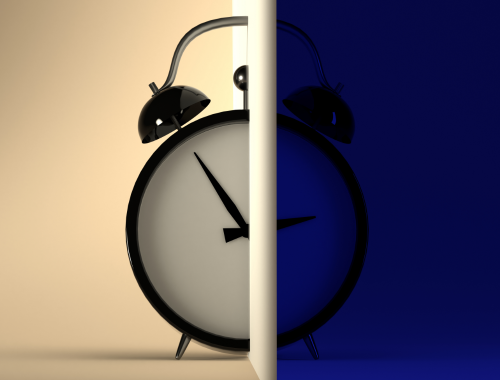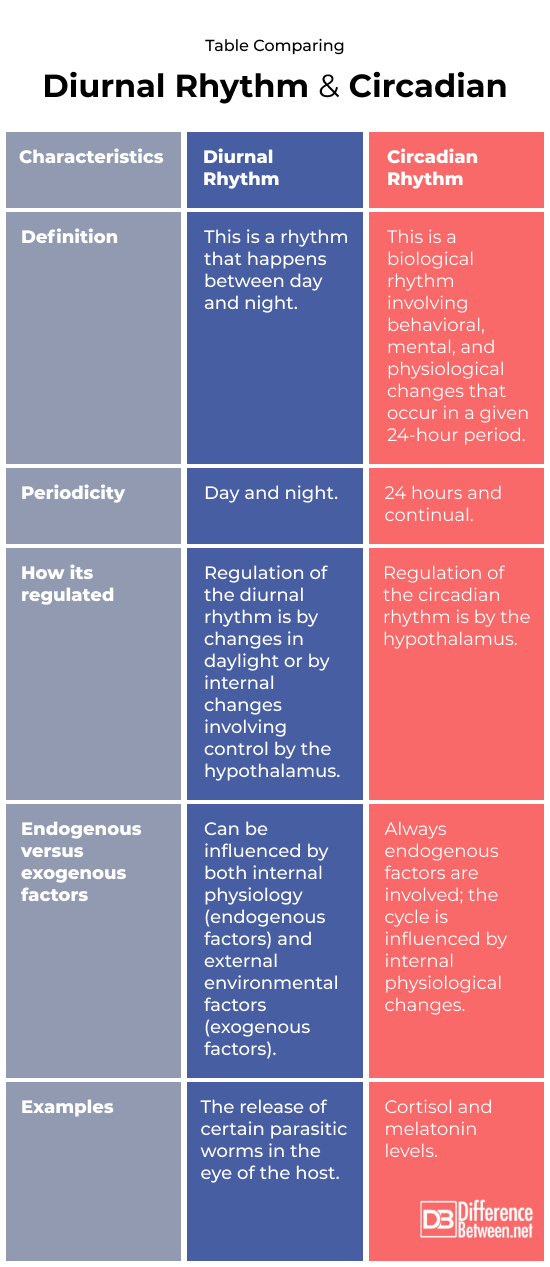Difference Between Diurnal Rhythm and Circadian
A diurnal rhythm is a change that happens from day to night. A circadian rhythm is a cycle that is continuous and occurs every 24 hours.

What is Diurnal rhythm?
Definition:
A diurnal rhythm is a biological rhythm that works in synchrony with the cycle of day and night.
Regulation of the cycle:
There can be control of the cycle by internal factors and also by external factors, which can include environmental cues. Some diurnal rhythms are controlled by parts of the hypothalamus since this controls hormone secretion. A diurnal rhythm that is controlled strictly by the hypothalamus may also be classified as a circadian rhythm if it is continuous.
Examples:
Photoperiod changes due to seasonal changes and this, in turn, affects bird activity. A change in daylight hours did affect body temperature of birds. This also impacted activity with the bird being more active for longer during the longer summer days than in winter. The diurnal rhythm of behavior changed accordingly. Another example of a diurnal rhythm is when a person is affected by the Loa loa worm and the microfilariae of the parasite are released during the day.

What is Circadian rhythm?
Definition:
A circadian rhythm is a cycle in nature that always repeats every 24 hours. It is a continuous occurrence that does not stop.
Regulation of the cycle:
Circadian rhythms are only internally controlled cycles. The control is by a part of the brain, called the suprachiasmatic nucleus. The suprachiasmatic nucleus is a region of nerve tissue that is found at the front of the hypothalamus. The hypothalamus regulates the hormone secretion activity of the anterior pituitary. It is both the hypothalamus and pituitary that are important in regulating the secretion of hormones in the body. It is these hormones that help continually maintain the circadian rhythms of an animal.
Examples:
Cortisol secretion in the human body is a good example. The level of cortisol in the blood is highest when we awaken and then, over the day, it decreases. Melatonin is another hormone that changes in concentrations on a daily basis. Melatonin is at the highest concentration at night and very early morning, so between about 11pm and 3am. Both hormones continue to cycle every 24 hours.
Difference between Diurnal rhythm and Circadian?
Definition
A diurnal rhythm is a rhythm that happens between the daytime and the nighttime. A circadian rhythm is a biological rhythm involving behavioral, mental, and physiological changes that occur in a 24-hour period.
Periodicity
The periodicity of a diurnal rhythm is only concerned with changes in day and night. A circadian rhythm changes continuously every 24 hours.
How it is regulated
Diurnal rhythms can be regulated by changes in daylight or by changes that are intrinsic and internally controlled by the hypothalamus. Circadian rhythms are internally controlled by the hypothalamus.
- Endogenous versus exogenous factors In the case of a diurnal rhythm, both internal physiology and external environmental factors can play a role. In the case of circadian rhythms, only internal factors are involved.
- Examples
An example of a diurnal rhythm is The release of certain parasitic worms in the eye of the host. An example of a circadian rhythm is the release of melatonin and cortisol.
Table comparing Diurnal rhythm and Circadian

Summary of Diurnal rhythm Vs. Circadian
- Diurnal rhythms and circadian rhythms are both types of natural cycles that occur in biology.
- A circadian rhythm is a continual cycle that happens every 24 hours.
- A diurnal rhythm is only concerned with a change or shift that happens between day and night.
- Some, but not all, diurnal rhythms are also circadian rhythms.
FAQ
Is diurnal and circadian the same thing?
No, diurnal and circadian are not specifically the same thing. Although some diurnal rhythms are sometimes considered to also be circadian rhythms, this is not always the case. Diurnal only refers to a change from day to night while circadian is a continuous cycle that completes and repeats every 24 hours.
What is a diurnal circadian rhythm?
This is a diurnal rhythm that is regulated internally and that continues to cycle every 24 hours. This is the case with certain hormones that are released in the body.
What is an example of a diurnal rhythm?
The release of certain parasitic worms of the species Loa loa follows a diurnal rhythm. The release of testosterone in men is an example of a diurnal rhythm, with peak levels of this hormone occurring at certain times of the morning.
What is the opposite of circadian rhythm?
Sleep-wake inversion in which people are active at night but then rest and sleep during the day is opposite of the usual circadian rhythm of sleeping and waking.
What is circadian rhythm another name for?
Circadian rhythm is another name for the body clock. This is also referred to sometimes as the biorhythm or biological rhythm.
- Difference Between Rumination and Regurgitation - June 13, 2024
- Difference Between Pyelectasis and Hydronephrosis - June 4, 2024
- Difference Between Cellulitis and Erysipelas - June 1, 2024
Search DifferenceBetween.net :
Leave a Response
References :
[0]Aledavood, Talayeh, Sune Lehmann, and Jari Saramäki. "Digital daily cycles of individuals." Frontiers in Physics 3 (2015): 73.
[1]Dawson, Alistair. "Daily cycles in body temperature in a songbird change with photoperiod and are weakly circadian." Journal of Biological Rhythms 32.2 (2017): 177-183.
[2]Steptoe, A., B. Serwinski, and G. Fink. "Stress: concepts, cognition, emotion, and behavior." Academic Press 1 (2016): 479-487.
[3]Image credit: https://www.canva.com/photos/MAC9dfW0sZ8-stellar-diurnal-motion/
[4]Image credit: https://www.canva.com/photos/MAE_iYThm34-circadian-rhythm-concept-alarm-clock-divided-into-two-parts-with-day-and-night-sleep-and-activity-mode-biorhythms-3d-render-/
